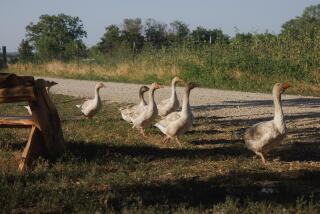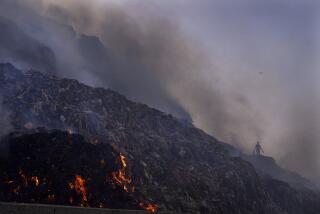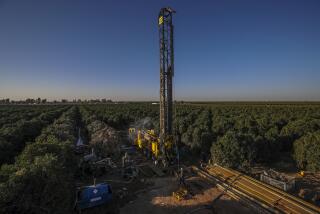Study Finds Serious Harm to 10% of World’s Best Soil : Environment: Human activity since WWII has ruined land, could lead to food shortages, U.N. reports.
- Share via
In a report with disturbing implications for the world’s food supply, a U.N. study has found that 10.5% of the planet’s most productive soil, an area the size of China and India combined, has been seriously damaged by human activity since World War II.
As many as 22 million acres have been so ruined by overgrazing, deforestation and unacceptable agricultural practices that they will be impossible to reclaim, says the report, which was released Tuesday. Almost 3 billion more acres, considered seriously damaged, can be restored, but only at great cost.
“It’s . . . a red alert,” agricultural scientist M. S. Swaminathan said of the report. Swaminathan is a leading authority on food production whose research over the past 30 years helped to triple India’s wheat harvest.
Unless something is done to reverse the trend, Swaminathan predicted, a food crisis is possible in the next 25 to 30 years as the world’s population of 5.5 billion climbs toward 8 billion.
“It will be very difficult to maintain global or national food security systems,” Swaminathan said in a telephone interview from Washington. “There will be an enormous shortage of food. Obviously, the poorer people will suffer more.”
The study marked the first time since World War II that soil conditions have been assessed on a global scale. The three-year survey involved more than 250 soil scientists throughout the world.
About two-thirds of all seriously eroded land is in Asia and Africa, home to most of the world’s poor, the survey found. In Central America, about 25% of the vegetated land is moderately to severely damaged. North America has the best record, with moderate to extremely damaged soil accounting for 4.4% of the total.
The findings were announced by the nonprofit World Resources Institute in association with the U.N. Environment Program, which funded the study. The study was coordinated by the International Soil Reference and Information Center in the Netherlands.
“It is alarming,” World Resources Institute President James Gustave Speth said from Washington. “The resource base to meet the required tripling of world food output is disappearing before our eyes. It’s happening on all continents, although it’s most severe in the developing world.”
While it is possible to offset the soil losses by applying more fertilizer, chemicals alone cannot reverse soil degradation and eventually may cause further damage, such as surface and ground water contamination, scientists said.
“We’re not talking about merely compensating for a decline in soil and water resources,” Speth said. “That won’t be nearly enough. We’re going to have to produce three times as much food on a resource base that is already badly stretched.”
Despite the much-acclaimed “green revolution” of the past several decades that produced unprecedented gains in food production through the introduction of fertilizers and hybrid grains, per-capita food production has declined in about 80 developing countries in the past decade, the study found. Soil degradation is thought to be a contributing factor.
Food production gains that did occur would have been even higher if soil losses had been lower, it found.
In North America, where rich prairie soils extend from the Midwest through the Great Plains into Canada, moderate damage from wind and water erosion continues, even though the United States boasts one of the world’s most advanced soil conservation programs.
A fourth of U.S. cropland is eroding at a rate faster than the U.S. Soil Conservation Service considers can be corrected, the report said. While soil conservation districts have begun to stabilize some areas, unwise farming practices could lead to further losses.
The report noted high water-erosion rates in California’s Central Valley, along the Mississippi and Missouri rivers, and in the hilly region of Washington state.
The study found that:
* Overgrazing, which accounts for 35% of the world’s degraded land, decreases vegetation, exposing the soil to water and wind erosion. Livestock also tramples and compacts the soil, reducing its capacity to retain moisture.
* Unsuitable agricultural practices, the second leading problem, are responsible for 28% of damaged soil. The losses result from using too much fertilizer, which can lead to soil acidification, or from cultivating hillsides without taking steps such as terracing to prevent soil erosion. Wind erosion results from failing to cover cropland during fallow periods. Soil salinity that reduces crop yields can occur if the land is not properly drained.
* Deforestation, which contributes to erosion and water contamination, is occurring most rapidly in Asia but is most widespread in South America. Overall, it accounts for 30% of the world’s impaired acreage.
“Only major investments and engineering works can restore some of these lands’ productivity,” the report said.
However, neither the U.N. report nor the World Resources Institute estimated what such an effort would cost, other than to acknowledge that it would run into billions of dollars.
Swaminathan said India paid an average of $2,000 to $3,000 per hectare (2.5 acres) to reclaim damaged soil.
Lightly damaged soils can be restored with crop rotation and minimum tillage, the study said. But restoring even moderately impaired land will take more resources than the average farmer can afford. Usually this involves draining the land to offset water-logging or salinity, or creating contour banks to prevent erosion.
Severely eroded land generally requires reclamation efforts beyond the means of most Third World nations, such as construction of drainage ditches or contour banks.
The 22 million acres of unreclaimable land includes areas that even the most extreme restoration efforts would not make productive.
The results of the study are contained in the 1992-93 issue of the World Resources Institute’s “World Resources,” an authoritative compendium of global resource issues and facts published every two years.






